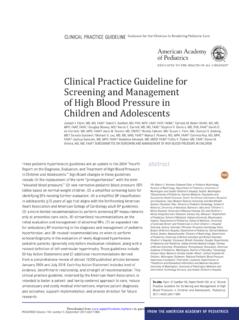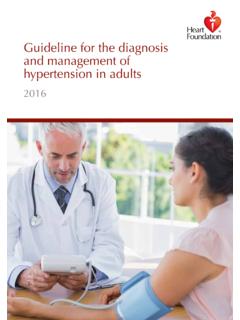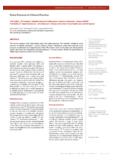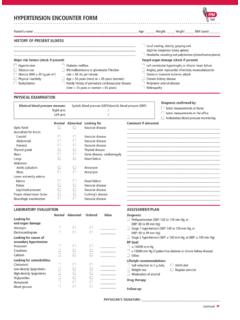Transcription of Ambulatory blood pressure monitoring
1 Draft for consultation purposes only not for citation. Draft: 24 November 2010. Position statement Ambulatory blood pressure monitoring November 2010. National Heart Foundation of Australia and the High blood pressure Research Council of Australia Position statement: Ambulatory blood pressure monitoring 1. Draft for consultation purposes only not for citation. Draft: 24 November 2010. [[Preliminary matter]]. [[Publication information to be added]]. [[Suggested citation to be added if published by Heart Foundation/HBPRCA]]. [[Table for editorial/consultation purpose; may not appear in final publication]].
2 Contents About this position statement .. 3. Context .. 3. Measuring ABP .. 5. Rationale for ABP monitoring in clinical practice .. 5. ABP reflects actual BP more closely than clinic measurements .. 5. ABP is a better predictor of clinical outcomes and end-organ 6. ABP monitoring can detect absence of nocturnal BP dipping .. 6. ABP monitoring is 7. When is ABP monitoring useful? .. 7. White-coat effect and suspected white-coat hypertension .. 8. Suspected masked hypertension .. 9. Borderline 10. Resistant hypertension .. 10. Elderly patients .. 10. Autonomic failure, orthostatic (postural) hypotension and syncope.
3 10. Hypertension in 11. Titrating antihypertensive medicines .. 11. Patients at high CVD 11. Episodic hypertension .. 11. Suspected sleep apnoea .. 11. Interpreting ABP .. 13. Normal BP levels in adults compared with clinic 14. Classification of hypertension in adults compared with clinic BP .. 14. Treatment targets in adults compared with clinic 15. Factors to consider when interpreting ABP .. 16. Practical considerations .. 18. Who should perform ABP monitoring ? .. 18. ABP monitoring devices .. 18. Importance of correct cuff size .. 18. Initial validation of readings in the clinic .. 19.
4 Position statement: Ambulatory blood pressure monitoring 2. Draft for consultation purposes only not for citation. Draft: 24 November 2010. Frequency of 19. Instructions for patients .. 19. How often should ABP monitoring be repeated?.. 20. Future research .. 20. Acknowledgements .. 21. Ambulatory blood pressure monitoring Working 21. Other 21. Appendix A. Development process .. 22. Consensus process .. 22. Endorsements .. 22. Appendix B. Classification of BP levels .. 23. References .. 25. About this position statement This document updates the Heart Foundation s 2002 position statement, Ambulatory blood pressure It incorporates revised blood pressure (BP) thresholds for the diagnosis and management of , 3.
5 This position statement was developed by the Ambulatory blood pressure monitoring Working Group (a subcommittee of the National Heart Foundation of Australia s National blood pressure and Vascular Disease Advisory Committee) and has been ratified by the Heart Foundation's Cardiovascular Health Advisory Committee and the High blood pressure Research Council of Australia. The working group considered the best available evidence from clinical trials and controlled observational studies, together with clinical expertise (Appendix A). Context This position statement supplements current national guidelines for the diagnosis and management of hypertension in Current Australian, international and most national guidelines for the management of hypertension emphasise that the necessity, choice and intensity of BP-lowering treatment should be determined by the individual s probability of an event within a given period (absolute CVD risk),4 based on thorough assessment and consideration of all risk factors ( age, sex, waist circumference and/or body mass index, lifestyle, family history, blood lipids, glucose metabolism)
6 And the presence of associated clinical conditions and/or end-organ Position statement: Ambulatory blood pressure monitoring 3. Draft for consultation purposes only not for citation. Draft: 24 November 2010. Summary of key points ABP monitoring : provides BP readings for daytime (awake), night-time (asleep) and 24-hour average, and provides data to calculate other parameters including BP variability and load. provides more reliable assessment of actual BP than clinic BP. enables detection of white-coat and masked hypertension identifies nocturnal non-dippers , who have a worse prognosis enables better prediction of end-organ damage associated with elevated BP, and risk of future cardiovascular events, than clinic or occasional BP measurements provides a reliable guide to therapy is cost-effective.
7 ABP monitoring should be arranged, where possible, when any of the following apply: suspected white-coat effect (including suspected white-coat hypertension). Patients with white-coat hypertension confirmed by ABP monitoring are at increased risk of hypertension and end-organ damage, and require continuing BP monitoring . suspected masked hypertension borderline hypertension before commencing an antihypertensive medicine regime hypertension despite appropriate treatment (including isolated systolic hypertension in the elderly). high risk of future cardiovascular events known or suspected episodic hypertension suspected sleep apnoea syncope or other symptoms suggesting orthostatic hypotension, where this cannot be demonstrated in the clinic possibility of autonomic failure hypertension of pregnancy.
8 Data obtained from ABP monitoring must be interpreted carefully with reference to diary information and timing of medicines. Reference normal ABP values for non-pregnant adults are: 24-hour average < 115/75 mmHg Daytime (awake) < 120/80 mmHg Night-time (asleep) < 105/65 mmHg. ABP thresholds for hypertension in adults are: Average over 24 hours 130/80 mmHg Daytime (awake) 135/85 mmHg Night-time (asleep) 120/75 mmHg. ABP values above normal and below thresholds for hypertension are considered high- normal . Night-time (sleeping) average systolic and diastolic BP should both be at least 10% lower than daytime (awake) average.
9 BP load (percentage time during which BP readings exceed hypertension threshold over 24. hours) should be < 20%. BP variability, maximum systolic BP and morning BP surge should also be taken into account (and targeted by treatment). Treatment targets based on ABP are lower than for clinic BP readings. Ideally, ABP monitoring should be performed by specialist monitoring centres. Only appropriately validated devices should be used for ABP monitoring . Arm circumference should be measured to select the correct cuff size. ABP readings may not be accurate when taken during exercise, movement or driving, or when the cardiac rate is irregular.
10 Position statement: Ambulatory blood pressure monitoring 4. Draft for consultation purposes only not for citation. Draft: 24 November 2010. Measuring ABP. Ambulatory blood pressure (ABP) monitoring involves the patient wearing a portable BP measuring device for a specified period (usually 24 hours), during which periodic BP measurements (usually every 20 30 minutes) are automatically taken via a cuff worn on the upper arm. The resulting series of BP readings, taken throughout the person s normal daytime activities and during sleep, provides a robust assessment of the impact of BP on the person s cardiovascular system (BP load).






